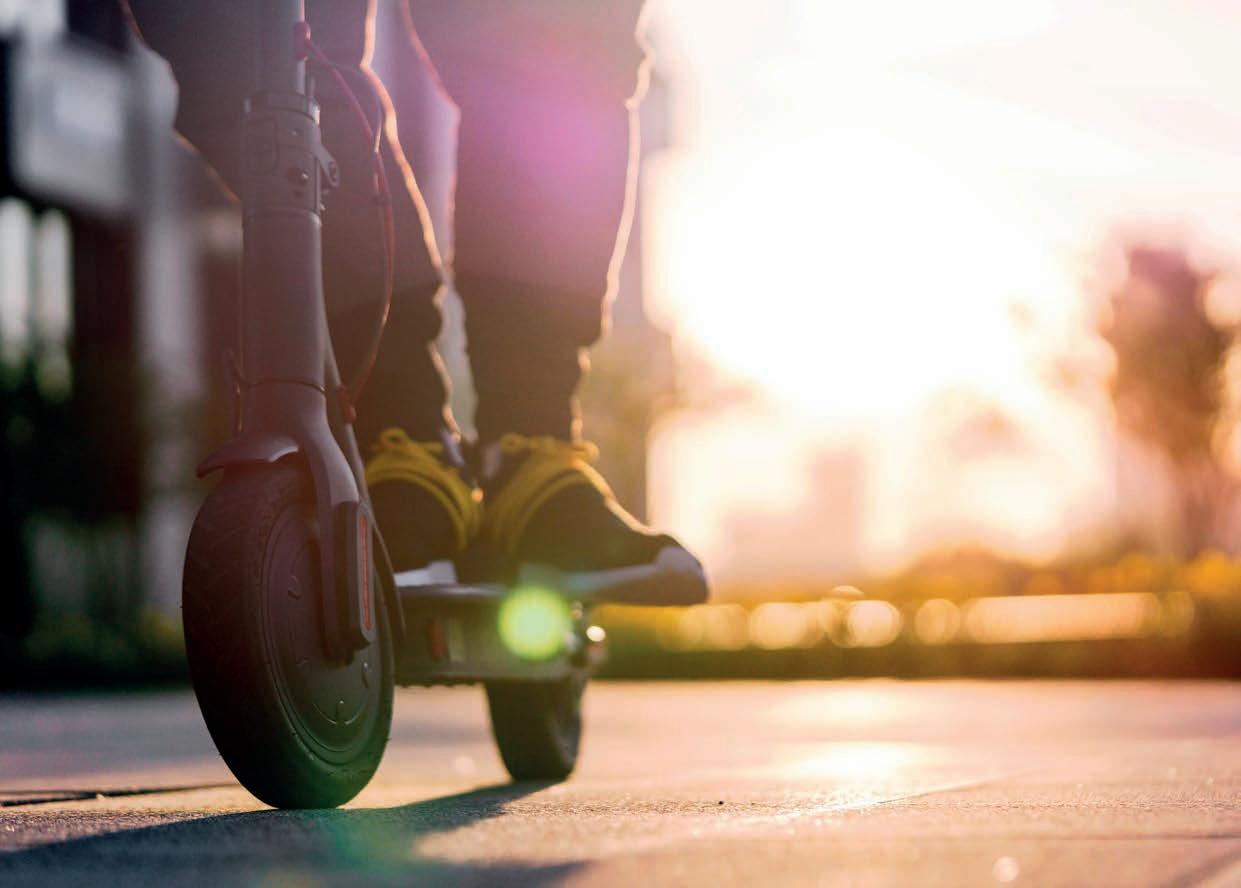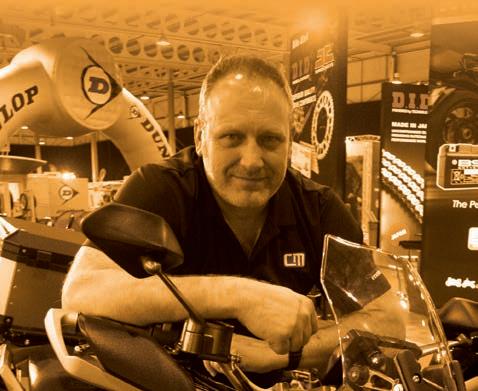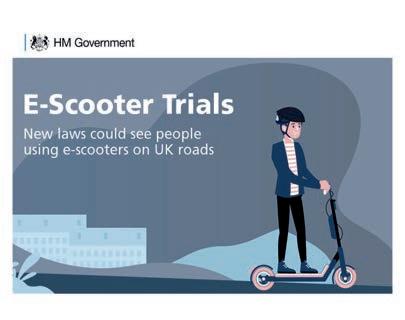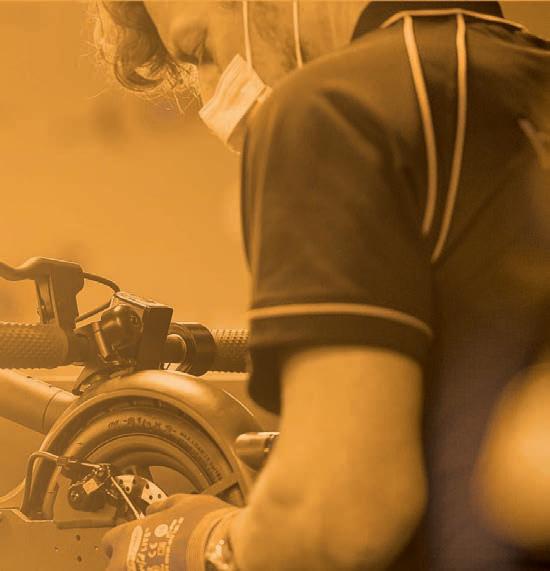
14 minute read
e-scooter storm






Scooting
up a storm
A perfect storm is brewing in towns and cities up and down the UK. Step-on batterypowered e-scooters have exploded in popularity amidst a morass of worries about safety and regulation – together with mixed messages from the authorities. BDN takes a look at what’s going on – and how it might a ect the motorcycle trade, for good or ill
Everyone has a story about e-scooters nowadays. Your mother-in-law nearly knocked one down driving along the local bypass the other night. The postman has to dodge them every day on the pavement. Your barber almost got in a fight after being cheeked by a gang of kids riding them outside his shop. And, of course, you’ve seen them yourself – two-up, weaving through traffic, crashing through red lights, bumping up on the pavement. They’re new and have exploded in popularity since last year’s Covid-19 lockdowns, with people looking for new ways to get about in urban environments without using crowded, possibly infected buses, trains, trams and tubes.
As part of the so-called ‘micro-mobility revolution’, they have a lot to offer – in theory at least. Having a zeroemissions (in use), efficient, batterypowered electric vehicle that can move commuters the last few miles between work or home and a train station makes a lot of sense. It’s certainly a better option than one person driving a massive Chelsea tractor. You can ride to your local suburban train station, fold your scooter up, take it on the train to Waterloo or
Waverley station, then unfold it, ride the three or four miles to the office and recharge it under your desk. Then at home time, do it all again, in reverse. Advances in rechargeable battery technology, compact high-power motors, and Chinese mass production means that a fairly light step-on scooter can be made and sold for as little as £400. The cheapest models are less than £200.
But there are, it seems, fundamental problems with the design. As Dean Clements of Clements Moto points out, the small wheels and a top speed of around 15mph means that e-scooters aren’t really suitable for use either on the road or on the pavement. “My main reservation about the step-on-scooter, beyond the legality, is how and where it is used,” Clements told us. “The product isn’t conducive to mixing with either pedestrians or cars.”
As Clements points out, there is a possible answer in the form of the cycle lane network – but it’s not good enough in the UK at the moment. “At present the only safe place I see them being used is in cycle lanes, of which we have far too few.”
But it’s the vague government regulation of e-scooters that seems to be causing most problems. On the one hand, the law is clear: private use of e-scooters is illegal in public places – parks, roads, pavements, cycle lanes, pedestrian shopping areas – and anyone doing so is committing a crime. In the UK, a powered vehicle and its user needs to comply with a whole range of laws around insurance, MOT testing, road tax, construction and use regulations, registration plates and licensing. There’s a loophole around electrically assisted pedal cycles or e-bikes which legally can only ‘assist’ a rider with 250 watts of extra power while they are pedalling, at speeds
up to 15.5mph. But in essence, if you have a self-powered, wheeled machine, it has much the same legal requirements as any car or motorbike.
There are two problems surrounding this, though. First, while it’s illegal to use a private e-scooter, it’s not illegal to sell them. And both online retailers and bricks-and-mortar businesses like Halfords are willing to sell the machines, with a disclaimer that they’re only for use on private land with the landowner’s permission. If the government had banned them from being sold to the public – like black race visors, battery acid or cannabis – they would be much harder to get hold of.
The second problem arrived last summer, when the UK government agreed to allow a series of e-scooter rental trials across the country. These are tightly regulated setups, with firms providing the infrastructure, insurance, and control over where and how the scooters can be used – as well as using properly-designed, high-quality commercial scooter designs. These have larger 10-12” wheels, are solidly-built, and contain smart GPS-enabled control software which controls
maximum speeds and can keep the scooter within a set area (so-called ‘geofencing’). Users are also linked to the scooters during the hire, so any rule-breaking, like riding on the pavement, can lead to punishment. Users have to undergo training (generally watching a video online), and also need to have a driving licence (though just a provisional licence is sufficient). Plus, riding an e-scooter while drunk is treated exactly like drink-driving in a car or motorbike.
The result of these two changes – unfettered private scooter sales plus trial rental schemes – was perhaps predictable. People see that there are ‘official’ e-scooters in use, and haven’t the foggiest idea about Department for Transport regulations. They see cheap e-scooters on an internet site for a few hundred pounds. They put two and two together and get five (hundred watts of scooter power), and within a few days, they’re out on the road/pavement/ park/shopping centre. Then, other people see them out and about – they must be legal? – and more sales ensue, with the snowballing effect we see now. The government, admittedly with its eye off the ball and attention taken up by a once-in-a-lifetime global pandemic, has let the genie out of the bottle. And getting it back in will be tough, since it’s now scooting
THE TRIALS


LAST SUMMER, THE UK GOVERNMENT set up rental e-scooter scheme trials with a number of firms including Spin – a micro mobility firm owned by automotive giant Ford. Spin is operating its e-scooters in a series of trial sites in the UK, including Milton Keynes, Basildon, Chelmsford and other towns in Essex.
We spoke to the firm’s UK and Ireland Country Manager, Steve Pyer, and asked him how it’s been working out. “The trials have gone really well for us. We’ve had over 250,000 journeys since we launched in Milton Keynes in August last year. Essex is also really strong – we have 12,00013,000 people riding in Essex.”
Is it essentially a young person’s thing? “There’s a fairly even split, and it’s no surprise that 18-30 is the biggest age group. One and a half percent of riders are over 80 though! But yes, riders are predominantly young, under 45.”
What about safety concerns – stability with small wheels, use on pavements, scooters going where they shouldn’t? “We have 10-inch wheels on the Spin, and the scooters we have are big and solid – they’re designed to be on the road. They can take impacts from falling over, they’re IP67rated so they can be out in all weathers. Some have suspension, and the tyres have some give. They’re not as good as a motorcycle, but they are designed to be used on the street.
“We have geofences and go-slow zones as well, and we can reduce the maximum speed to 10mph where there’s busier footfall. In Basildon’s central shopping area, you’re not allowed to ride bicycles or scooters on market day, so we’ve geofenced that area and you can’t ride there. And across Essex, some people complained that 15mph was too fast, so we reduced speeds to 12.5mph.”
So, a successful regulated trial, from Spin’s point of view. Does Pyer see the trials continuing and rental use becoming fully legal?
“I think the trials are going to be extended till next March, according to the DFT, assuming the cities want to continue. After that, I don’t really know, and there’s a hiatus in theory between the trials ending and legislation coming in. But there are so many people employed in this industry, and I think it would be very difficult and very harsh if the DFT said ‘we’re going to stop it until we have legislation’.
“Parliament has to approve changes to the law, so I think, realistically, we’re looking at next summer, when parliament reconvenes, and we have the Queen’s speech. I’m looking forward to Her Majesty saying e-scooters are now going to be legal!”
What about private use? Can Pyer see that as the endpoint? “I think it makes sense. It’s not illegal to buy or sell e-scooters, You can buy these things at many retailers, and they should all stipulate that you can only use them on private land. But you see them everywhere, and I think the cat is out of the bag. I think legislation is inevitable since it’s impossible to put the cork back in that bottle (to mix the metaphors). And, if you get proper legislation, you’ll have scooters like in our rental scheme: big, solid, robust, and limited within the rules like an e-bicycle.”
But Pyer is aware that not everyone will be pleased with that, initially at least. “E-scooters aren’t for everyone, and it’s like the bicycle debate, people are for and against it. But we have a massive section of the community across Essex who love them! They really enjoy it – but it’s not for everyone. I do think people will become used to them.”







The trials are in full swing across many towns and cities, but some riders don’t stick to the rules
about at 15mph on the pavements, in silence, without any PPE on…
So far, so what? Why are you reading about this in your favourite motorcycle trade bible? Well, there are two ways of looking at the e-scooter trend – as a threat or as an opportunity. Apart from the obvious threats to road safety, and pressure upon law enforcement, a lot of e-scooter riders could well have been your customers. If you were a young commuter on an FS-1E in the 1970s, a Honda MB-5 in the 1980s, or a Piaggio Typhoon in the 1990s and beyond, you’re probably learning to wheelie an e-scooter right now. The faff around CBT, insurance, helmet, road tax, A1 licencing – it’s all gone. Add in the influence of social media, and the potential for hilarious but dangerous TikTok videos, and you can see why e-scooters seem like catnip to modern youth. And youth is something that the motorcycle market definitely needs more of.
There is an obvious opportunity. You could easily buy a container of cheap no-name scooters from AliBaba.com, pile them high and sell them cheap, no questions asked. You could even do the job properly, and buy robust, higher-quality scooters from a proper firm like Xiaomi, insist that users buy a helmet at the same time, and make a big deal out of the fact they’re not for use on the road. If Halfords is doing it, why not join them – and point any disgruntled customers who’ve had their scooters confiscated by the police to the small print on the invoice.
It’s a choice of course, and who could blame retailers for trying to get money in the door after the misery of the pandemic. But Paddy O’Connell, head of operations at the NMDA suggests it’s not one that many dealers are interested in. “I’ve not had any reports of anyone actually selling e-scooters yet. George Dennison of MotoDen is quite a vocal member of the NMDA, and because of where he’s based in London, he’d be one of the primary beneficiaries of this. But his

IMPORTER’S VIEW
DEAN CLEMENTS OF CLEMENTS Moto spoke to BDN about the scenario the firm faces with e-scooter retailing, and how it’s addressing it.
“Just last week we had a distribution presentation from Fantic, who will be launching two step-on-scooters next month. My personal preferences are irrelevant, and I have to consider what we do with this commercially. Fantic has introduced the product to quench demand coming from the retail outlets stocking our eBikes. Since introduction, eBikes have very quickly become intrinsic to our business with Fantic and whether due to pandemic or underestimation in general, the performance curve of this has outperformed both mine and Fantic’s business plan.
“In many countries there’s no question to ask and the scooters will be launched. In the UK, I have the benefit of being in a position to make the decision. Fantic understands that in the UK, as with some other countries, the product is not legal when used in the public domain. We could take the Halfords approach and retail beside a disclaimer. But as things stand, we will not introduce it until the situation is legalised or circumstances change to make me think again.”
Clements also has some thoughts on how the sector – and its regulation – will develop over the medium term. “As I understand, the official tests are still under government review. How that review will find is up for speculation, but either way it won’t be instantaneous and it will take time to pass legislation. My view is there are too many ‘tests’, with too much investment made, for central government to decide they will just outlaw it in all forms. I think more likely there will be legislation passed that will require displayed serial numbers, (if not registration numbers), insurance and some form of rider ID/Licencing, but unlikely to be full CBT.
“I would expect this to be part of a bigger shift in government changes to micro mobility and that this will include eBikes and specifically speed pedelecs restricted to 45km/h. Incidentally, Fantic have two urban eBikes pending type approval and nearing launch in this category. This in my opinion is better fitting for our current business, as it bridges the void between our eBikes and motorcycles.”
Clements Moto MD Dean Clements thinks e-scooters could be part of his business’s future offering when legislation has been finalised
opinion is he’s not going to sell these until they’re legal. And he’ll stick to that.
“It also feels like that it would be taking away from the main business because it’s such a lowmargin item. Why get involved until things are sorted?” The NMDA is Rather, the NMDA is pushing pushing the the government government in a different way – towards in a di erent regulation schemes that way – towards could include regulation PTW dealers. Which could schemes that then have a positive effect on could include the powered two- PTW dealers wheeler market by acting as a gateway towards ‘proper’ motorcycles and scooters.
Paddy O’Connell again; “We think the minimum age for e-scooters should be 14, and people should have to do an online course to get a mini-licence. That could be extended into a mini ‘CBT’ type test – and our dealers could run that training. Then, if it was a two-year provisional e-scooter licence, what happens when you’re 16? You’ll be back in the motorcycle showroom … “I think we do see it as an opportunity, as a gateway into PTW, and the electric bikes of the future. But they need to be regulated; we need the safety regulations and also the roadworthiness of the users too. That needs to be part of the process, written down in stone.” It’s an intriguing possibility – and could be a really good next chapter to the e-scooter saga. As it is, it looks like there will be plenty of scary stories about e-scooters for quite a while yet.
We want your views
Extended e-scooter coverage from BDN will be reported online and in the August issue of the magazine. Your thoughts and opinions are welcome. Are they killer scoots, or is it time for the trade to fill their boots? editorial@dealernews.co.uk












